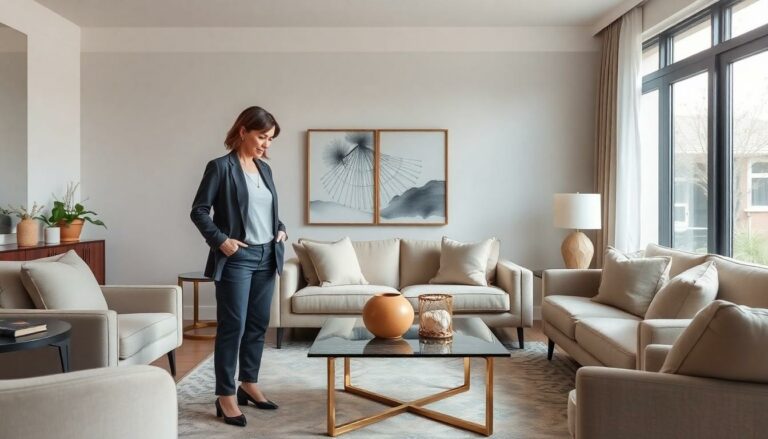In a world where first impressions are everything, the right interior design can transform a drab space into a dazzling masterpiece. An interior design associate degree opens the door to a colorful career filled with creativity and innovation. Whether it’s turning a bland office into a vibrant workspace or making a cozy nook in a home, this degree equips aspiring designers with the skills to make magic happen.
Overview Of Interior Design Associate Degree
An interior design associate degree equips students with foundational skills in design principles, color theory, and spatial arrangements. Courses in these programs typically cover drafting techniques and software applications, ensuring students are proficient in industry-standard tools. Program structures often blend classroom instruction with hands-on experience, allowing learners to apply theory in practical projects.
Degree durations generally span two years, providing a concise pathway into the interior design field. Graduates frequently pursue entry-level positions such as design assistants or staging coordinators. Employment opportunities often arise in sectors like residential design, commercial spaces, and healthcare environments.
Some programs emphasize sustainable practices, teaching students how to create eco-friendly designs that cater to modern needs. Networking opportunities usually exist through workshops and design expos, enhancing students’ connections within the industry. Certificates in specialized areas, such as CAD design or green design, may also supplement an associate degree, increasing job competitiveness.
Internships commonly serve as a vital aspect of these programs, allowing students to gain real-world experience and develop portfolios. Additionally, many institutions provide career services to assist with job placement. Exploring various styles and trends during coursework helps students forge their unique design identities.
Ultimately, an interior design associate degree serves as a quality stepping stone for those eager to make an impact within the design world.
Curriculum Highlights

Curriculum highlights of an interior design associate degree focus on essential skills and concepts relevant to the field. Students engage in a variety of courses that equip them for future roles in design.
Core Courses
Core courses provide foundational knowledge in interior design. Design principles introduce students to essential concepts for crafting effective spaces. Color theory explores how different hues interact, influencing mood and perception. Spatial arrangements teach practical techniques for optimizing layouts to enhance functionality. Drafting techniques develop skills in creating accurate representations of designs, while software applications cover industry-standard tools like AutoCAD and SketchUp. These courses foster a solid base necessary for tackling various design challenges.
Elective Courses
Elective courses offer additional breadth and depth to the curriculum. Options may include studies in sustainable design practices, which emphasize environmentally responsible choices throughout projects. Business management allows designers to understand the commercial aspects of running a design firm effectively. History of interior design provides insights into design evolution, enriching a student’s perspective. Advanced rendering techniques enhance visualization skills, improving communication with clients. Participating in these electives helps tailor the educational experience to specific interests and career aspirations.
Career Opportunities
An interior design associate degree opens diverse career pathways in the design industry. Graduates frequently secure entry-level positions across various sectors including residential, commercial, and healthcare design.
Job Roles
Numerous job roles await graduates with an interior design associate degree. Designers often find themselves as junior designers, assisting in project development and client consultations. Many pursue positions as design assistants, supporting senior designers with research and material selection. Some enter production coordination, overseeing the logistics of design projects. Others might specialize as space planners, optimizing layouts in residential or commercial settings.
Salary Expectations
Salary expectations for interior design graduates can vary by role and location. Entry-level positions typically offer salaries ranging from $35,000 to $45,000 annually, depending on experience and geography. Designers working in urban areas often earn higher wages due to increased demand. Experienced professionals in specialized roles may see salaries exceeding $70,000. As individuals gain industry experience, their earning potential can significantly increase, particularly when advancing into managerial positions.
Benefits Of Pursuing An Associate Degree
Pursuing an associate degree in interior design offers numerous advantages for aspiring designers. One major benefit is the foundational knowledge acquired in design principles and techniques. This knowledge lays a strong groundwork for future studies or entry-level positions in the field.
Hands-on experience is another key advantage of these programs. Students engage in studio work that enhances their creativity and practical skills, allowing them to tackle real-world design challenges. Internships often accompany coursework, providing invaluable opportunities to build professional portfolios.
Networking opportunities abound in associate degree programs. Students connect with industry professionals, which can lead to job offers and mentorships. Engaging with peers in collaborative projects fosters teamwork skills essential for success in the design industry.
Affordability remains a compelling factor when considering an associate degree. These programs typically require less time and financial investment compared to bachelor’s degrees. Graduates enter the workforce sooner, allowing them to gain experience while also earning a salary.
Job placement rates often reflect the effectiveness of these programs. Many graduates find entry-level positions within months of completing their degrees. Career pathways such as junior designer or design assistant provide solid starting points to grow within the industry.
Flexibility in coursework allows students to tailor their education to specific interests. Elective courses in sustainable design or business management can enhance career prospects. With specialized skills, graduates stand out in a competitive job market.
Overall, pursuing an interior design associate degree equips individuals with essential tools for professional success. Graduates possess the skills and experiences needed to thrive in diverse design fields.
Challenges In The Field
Navigating the interior design field involves various challenges. Competition remains a significant hurdle, with numerous aspiring designers entering the job market each year. Adapting to ever-evolving design trends requires continuous learning and creativity.
Meeting client expectations poses its own set of difficulties. Designers often find it challenging to balance personal style with a client’s vision while adhering to budget constraints. Communication skills play a crucial role; effectively conveying ideas and concepts to clients and contractors becomes essential.
Understanding legal and regulatory requirements can also complicate projects. Compliance with building codes, safety regulations, and accessibility standards is necessary to avoid legal issues. Missing these elements can lead to costly setbacks and project delays.
Sourcing sustainable materials adds another layer of complexity. Eco-friendly design choices often involve navigating a narrower market, which can increase costs and reduce availability. Finding products that align with both sustainability and aesthetic goals remains a crucial challenge for many designers.
Technology impacts the field as well. Designers must stay updated with advanced software tools and digital design trends. Learning new applications like virtual reality or 3D modeling can be time-consuming and requires a commitment to ongoing education.
Finally, managing project timelines and budgets requires strong organizational skills. Designers juggle multiple projects simultaneously, making it vital to prioritize tasks effectively. Delays or budget overruns can damage client relationships and impact future opportunities.
Conclusion
Pursuing an interior design associate degree opens doors to a dynamic and rewarding career. Graduates gain essential skills that empower them to create innovative and functional spaces. With a blend of theoretical knowledge and practical experience, they are well-prepared to navigate the competitive landscape of interior design.
The degree not only enhances creativity but also provides valuable networking opportunities that can lead to job placements. As the demand for skilled designers continues to grow, this educational path offers a promising future. Embracing the challenges of the industry can lead to fulfilling careers that leave a lasting impact on the built environment.





